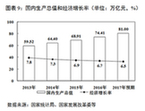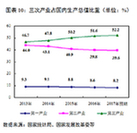【中英文對照】2017年國民經(jīng)濟和社會(huì )發(fā)展計劃報告(全文)
| 二、2017年經(jīng)濟社會(huì )發(fā)展的總體要求、主要目標和政策取向 | II. Requirements, Objectives, and Policies for Economic and Social Development in 2017 |
| 2017年是實(shí)施“十三五”規劃的重要一年,是供給側結構性改革的深化之年。中國共產(chǎn)黨第十九次全國代表大會(huì )將要召開(kāi),具有重大而深遠意義。做好2017年經(jīng)濟工作至關(guān)重要。 | 2017 is an important year in implementing the 13th Five-Year Plan (2016-2020) and in carrying out further supply-side structural reform. 2017 will also witness the convocation of the 19th National Congress of the CPC, an event of far-reaching significance. So it is of paramount importance for us to effectively carry out our economic work over the coming year. |
| (一)總體要求 | 1. General Requirements |
| 在以習近平同志為核心的黨中央領(lǐng)導下,高舉中國特色社會(huì )主義偉大旗幟,全面貫徹黨的十八大和十八屆三中、四中、五中、六中全會(huì )精神,以鄧小平理論、“三個(gè)代表”重要思想、科學(xué)發(fā)展觀(guān)為指導,深入貫徹習近平總書(shū)記系列重要講話(huà)精神和治國理政新理念新思想新戰略,統籌推進(jìn)“五位一體”總體布局和協(xié)調推進(jìn)“四個(gè)全面”戰略布局,堅持穩中求進(jìn)工作總基調,牢固樹(shù)立和貫徹落實(shí)新發(fā)展理念,適應把握引領(lǐng)經(jīng)濟發(fā)展新常態(tài),堅持以提高發(fā)展質(zhì)量和效益為中心,堅持宏觀(guān)政策要穩、產(chǎn)業(yè)政策要準、微觀(guān)政策要活、改革政策要實(shí)、社會(huì )政策要托底的政策思路,堅持以推進(jìn)供給側結構性改革為主線(xiàn),適度擴大總需求,加強預期引導,深化創(chuàng )新驅動(dòng),全面做好穩增長(cháng)、促改革、調結構、惠民生、防風(fēng)險各項工作,保持經(jīng)濟平穩健康發(fā)展和社會(huì )和諧穩定,以?xún)?yōu)異成績(jì)迎接黨的十九大勝利召開(kāi)。 | The requirements for 2017 are as follows: -- uphold the leadership of the CPC Central Committee with Comrade Xi Jinping at its core -- hold high the great banner of socialism with Chinese characteristics -- fully implement the guidelines from the 18th National Party Congress and from the third, fourth, fifth, and sixth plenary sessions of the 18th Party Central Committee -- follow the guidance of Deng Xiaoping Theory, the Theory of Three Represents, and the Scientific Outlook on Development -- put into practice the guiding principles from General Secretary Xi Jinping's major addresses and his new concepts, thoughts, and strategies on the governance of China -- promote coordinated economic, political, cultural, social,and ecological progress and balanced implementation of the Four-Pronged Comprehensive Strategy* -- seek progress while keeping performance stable -- build a strong understanding of and put into practice China's new development philosophy -- adapt to, approach in the right way, and steer the new normal in economic development -- take strengthening the quality and benefits of development as a core priority -- ensure macro policies are stable, industrial policies are targeted, micro policies are flexible, reform policies are practical, and that social policies ensure basic needs are met -- focus on supply-side structural reform -- expand aggregate demand as appropriate -- better guide expectations -- ensure development is increasingly innovation-driven -- work to keep growth stable, promote reform, make structural adjustments, improve living standards, and guard against risks -- maintain stable and sound economic development as well as social harmony and stability Fulfilling these requirements should ensure that we greet the 19th National Party Congress with outstanding achievements. * To make comprehensive moves to finish building a moderately prosperous society in all respects, deepen reform, advance the law-based governance of China, and strengthen Party self-governance. |
| (二)主要預期目標 | 2. Main Objectives |
| 按照上述總體要求,綜合考慮需要和可能,提出2017年經(jīng)濟社會(huì )發(fā)展的主要預期目標: | Keeping the above requirements in mind and fully considering both what is necessary and what is possible, we have set the following objectives for economic and social development in 2017: |
| ——經(jīng)濟增速保持在合理區間。國內生產(chǎn)總值預期增長(cháng)6.5%左右,在實(shí)際工作中爭取更好結果。主要考慮:一是符合客觀(guān)實(shí)際。我國經(jīng)濟發(fā)展已經(jīng)進(jìn)入新常態(tài),經(jīng)濟增速從高速增長(cháng)轉向中高速增長(cháng)。2016年我國經(jīng)濟總量超過(guò)74萬(wàn)億元,今年預期6.5%左右的增量,超過(guò)2016年6.7%的增量,同世界主要國家相比也是很高的速度。二是符合全面建成小康社會(huì )目標要求。與“十三五”規劃目標相銜接,在2016年已經(jīng)實(shí)現6.7%增長(cháng)的基礎上,今后4年,只要年均增長(cháng)6.5%左右,就可以實(shí)現2020年國內生產(chǎn)總值比2010年翻一番的目標。三是能夠滿(mǎn)足就業(yè)目標需要。保持經(jīng)濟發(fā)展速度、推動(dòng)經(jīng)濟發(fā)展,根本還是要不斷解決好人民群眾普遍關(guān)心的突出問(wèn)題。四是有利于形成良好社會(huì )預期。2017年面臨的國內外環(huán)境仍然復雜多變,要引導各方面更加注重堅持以提高發(fā)展質(zhì)量和效益為中心,集中精力推動(dòng)結構優(yōu)化升級,積極應對各種不確定因素影響,為深入推進(jìn)供給側結構性改革創(chuàng )造良好環(huán)境。 | -- Economic growth within an appropriate range GDP is projected to grow by 6.5% approximately; however in practice, we will strive for better. In setting this objective, we have taken the following into account: First, the projected GDP growth rate is in keeping with conditions in China. Our country is in a new normal in economic development, having shifted from a high to a medium-high growth rate. In 2016 China's aggregate economic output exceeded 74 trillion yuan; and this year's projected growth rate of around 6.5% will result in a larger increase in economic output than last year's increase resulting from a 6.7% growth rate. Moreover, a growth rate of 6.5% is much higher than most major economies. Second, the projected growth rate is in line with the goal of finishing building a moderately prosperous society in all respects. China's economy grew by 6.7% in 2016, so an average growth rate of around 6.5% over the next four years would be sufficient to accomplish the objective set out in the 13th Five-Year Plan to ensure that China's GDP in 2020 is double what it was in 2010. Third, a 6.5% growth rate is needed to achieve the employment objective. All efforts to keep the economy growing at an appropriate rate and to promote economic development are for nothing more than to address the problems which are of most concern to the public. Fourth, this rate of growth is conducive to fostering healthy public expectations. Facing complex and volatile situations at home and abroad in 2017, we need to provide guidance to all sectors of society so as to focus efforts on improving the quality and benefits of development and promoting structural improvement and upgrading, ensure a proactive response to the impact arising from various uncertainties, and create a favorable environment for supply-side structural reform. |
圖表9:國內生產(chǎn)總值和經(jīng)濟增長(cháng)率 新華社發(fā) | Figure 9. GDP and Growth Rate |
| ——就業(yè)形勢保持總體穩定。城鎮新增就業(yè)1100萬(wàn)人以上,比2016年預期目標多100萬(wàn)人,城鎮登記失業(yè)率控制在4.5%以?xún)取V饕紤]:一是就業(yè)壓力較大。預計2017年仍有1500萬(wàn)左右新成長(cháng)勞動(dòng)力進(jìn)入市場(chǎng),加上去產(chǎn)能行業(yè)職工轉崗需求有所增加,考慮退休等騰退的城鎮就業(yè)崗位,需要新增約1100萬(wàn)人的城鎮就業(yè)。二是就業(yè)容量不斷擴大。隨著(zhù)產(chǎn)業(yè)結構調整,特別是創(chuàng )新創(chuàng )業(yè)和服務(wù)業(yè)發(fā)展,就業(yè)彈性系數明顯提高,6.5%左右的經(jīng)濟增長(cháng),可以實(shí)現就業(yè)目標,實(shí)際完成數量還可以力爭更多一些。三是實(shí)現城鄉居民收入增長(cháng)與經(jīng)濟增長(cháng)基本同步的需要。體現了黨和政府以人民為中心的發(fā)展思想和民生為先、就業(yè)為本的執政理念,有利于穩定預期和增強發(fā)展信心。 | -- Overall stable employment Over 11 million new urban jobs will be created, 1 million more than the projection for 2016, and the registered urban unemployment rate should stay within 4.5%. In setting these objectives, we have taken the following into account: First, employment pressure is mounting. About 15 million new workers will enter the job market in 2017, and there will also be a slightly larger number of laid-off workers that need to be reemployed in other industries due to the scaling-down of overcapacity; on the other hand, we will see jobs opening up in urban areas as a result of retirements. Taking these factors into consideration, we need to create around 11 million new urban jobs this year. Second, employment capacity continues to increase. Due to adjustments in the structure of industry, particularly in terms of entrepreneurship and innovation and the development of the service sector, China's employment elasticity has risen considerably. A growth rate of around 6.5% should ensure that we fulfill our employment target and will allow us to work toward exceeding it. Third, we need to ensure increases in personal income are basically in step with economic growth. These objectives are a reflection of the Party and government's vision of people-centered development as well as the governance principle that the people's wellbeing comes first and ensuring employment is a top priority. They are also conducive to ensuring stable public expectations and strengthening people's confidence in development. |
| ——價(jià)格總水平基本穩定。居民消費價(jià)格漲幅預期目標為3%左右。主要考慮:一是2017年翹尾因素約為0.6%,與去年基本持平。二是2016年9月以來(lái),工業(yè)生產(chǎn)者出廠(chǎng)價(jià)格指數(PPI)由負轉正,工業(yè)領(lǐng)域通縮壓力有所緩解,但PPI向下游產(chǎn)業(yè)和終端消費傳導,以及進(jìn)口商品價(jià)格傳導和國際大宗商品價(jià)格上升走勢的影響,將會(huì )形成新的漲價(jià)因素。三是為價(jià)格改革預留出空間。 | -- Overall stable prices The CPI is projected to increase by around 3%. In setting this objective, we have taken the following into account: First, the carryover effect from the CPI increase in 2016 will be 0.6%, which is basically the same as that of the year before. Second, the producer price index (PPI) shifted from negative to positive territory in September 2016 and has remained there ever since, and the deflationary pressure on manufacturing has eased to some extent. However, as the effects of the PPI increase are transmitted to downstream industries and toward end consumption, and as the prices of imported goods and international commodity prices rise, new factors will emerge to push up prices. Third, such a CPI increase leaves us with room to undertake price reform. |
| ——國際收支保持基本平衡。繼續促進(jìn)貨物貿易回穩向好,服務(wù)貿易較快增長(cháng),利用外資規模保持穩定,對外投資健康發(fā)展。主要考慮:一是世界經(jīng)濟和貿易增長(cháng)低迷的狀況短期內難以改變,但隨著(zhù)促進(jìn)外貿穩增長(cháng)調結構政策成效進(jìn)一步顯現,貨物進(jìn)出口有望繼續回穩向好。二是電信、計算機和信息等高附加值服務(wù)出口繼續較快增長(cháng),服務(wù)貿易結構將更加優(yōu)化。三是大力營(yíng)造公平、透明、可預期的法治化市場(chǎng)營(yíng)商環(huán)境,利用外資將保持穩定,質(zhì)量將進(jìn)一步提高。四是對外投資活躍,為避免非理性投資引發(fā)經(jīng)營(yíng)、債務(wù)等風(fēng)險,應穩妥有序推進(jìn)對外投資。 | -- A basic balance in international payments We will continue to promote a steady rise in the trade of goods, rapid growth in the trade of services, stability in the use of foreign investment, and the healthy development of outbound investment. In setting these objectives, we have taken the following into account: First, a turnaround in global economic and trade growth is unlikely in the short term. However, as the policy for promoting steady growth and structural adjustment in foreign trade continues to have an effect, the volume of trade in goods is expected to pick up again. Second, as the export of high-value-added services such as telecommunications, computers, and information continues to increase rapidly, the structure of trade in services will improve. Third, significant efforts will be made to create a fair, transparent, and predictable law-based market environment so as to ensure foreign investment remains stable and improves in quality. Fourth, outbound investment will be robust. In order to avoid irrational investment which may give rise to operational or debt risks, growth in this area should be promoted in an orderly and prudent manner. |
| ——發(fā)展的質(zhì)量和效益進(jìn)一步提高。消費對經(jīng)濟增長(cháng)的貢獻率提高。農業(yè)基礎進(jìn)一步加強,去產(chǎn)能工作扎實(shí)推進(jìn),戰略性新興產(chǎn)業(yè)加快發(fā)展,服務(wù)業(yè)增加值占國內生產(chǎn)總值的比重繼續提高。研究與試驗發(fā)展經(jīng)費投入強度和科技進(jìn)步貢獻率進(jìn)一步提高。單位國內生產(chǎn)總值能耗下降3.4%以上、二氧化碳排放下降4.0%,主要污染物排放量繼續下降,大氣、水環(huán)境質(zhì)量進(jìn)一步改善。主要考慮:貫徹創(chuàng )新、協(xié)調、綠色、開(kāi)放、共享的發(fā)展理念,促進(jìn)產(chǎn)業(yè)轉型升級、提質(zhì)增效,全面提高產(chǎn)品和服務(wù)質(zhì)量,加強節能環(huán)保和生態(tài)建設,符合推進(jìn)供給側結構性改革的要求,有利于創(chuàng )造新的增長(cháng)點(diǎn),提高經(jīng)濟增長(cháng)潛力,推動(dòng)經(jīng)濟保持中高速增長(cháng)、邁向中高端水平。 | -- Improved quality and benefits in development The contribution of consumption to economic growth will increase. The foundation of agriculture will be further strengthened; solid progress will be made in cutting overcapacity; the development of emerging strategic industries will be accelerated; and increases in the contribution of the value-added of the service sector to GDP will be sustained. More will be spent on research and development and there will be an increase in the contribution of scientific and technological progress to economic growth. Energy consumption per unit of GDP will be reduced by at least 3.4%, carbon dioxide emissions per unit of GDP will be cut by 4.0%, reductions in the emissions of major pollutants will continue, and air and water quality will be further improved. In setting these objectives, we have taken the following into account: We need to put into practice the philosophy of innovative, coordinated, green, open, and shared development; see that industries are transformed and upgraded, that their quality and performance improves, and that the quality of all products and services increases; and ensure that energy conservation, environmental protection, and ecological improvement efforts are strengthened. These objectives are in line with the efforts to advance supply-side structural reform, and can help to create new growth areas, increase the potential for economic growth, and ensure the economy maintains a medium-high growth rate and moves toward the medium-high end. |
圖表10:三次產(chǎn)業(yè)占國內生產(chǎn)總值比重 新華社發(fā) | Figure 10. Contribution to GDP by the Primary, Secondary, and Tertiary Industries |
| ——民生福祉進(jìn)一步改善。農村貧困人口再減少1000萬(wàn)人以上,完成340萬(wàn)人易地扶貧搬遷建設任務(wù)。戶(hù)籍人口城鎮化率提高1個(gè)百分點(diǎn)以上,農業(yè)轉移人口和其他常住人口在城鎮落戶(hù)1300萬(wàn)人以上。教育衛生文化等基本公共服務(wù)均等化水平進(jìn)一步提高,義務(wù)教育鞏固率和高中階段教育毛入學(xué)率穩步提高。社會(huì )保障制度進(jìn)一步完善,覆蓋面繼續擴大,保障水平適度提升。城鄉居民基本醫保人均財政補助標準提高到450元,大病保險籌資水平進(jìn)一步提高。人口自然增長(cháng)率7.5‰左右。主要考慮:全面落實(shí)以人民為中心的發(fā)展思想,在學(xué)有所教、勞有所得、病有所醫、老有所養、住有所居上持續取得新進(jìn)展。 | -- Improvements in living standards The number of people living in poverty in rural areas will be reduced by at least 10 million, and 3.4 million people will be relocated from inhospitable areas so as to help them shake off poverty. The percentage of registered urban residents will increase by more than 1 percentage point. Urban residency will be granted to an additional 13 million people with rural household registration living in urban areas and other permanent urban residents. Access to basic public services such as education, health, and culture will become more equitable. The retention rate of compulsory education and the gross enrollment ratio for senior secondary education will continue to rise. The social security system will be further improved with more beneficiaries receiving coverage and an appropriate increase in benefits. Per capita government subsidies for basic medical insurance for rural and non-working urban residents will increase to 450 yuan, while the level of financing for the major disease insurance scheme will also be raised. The natural population growth rate will be about 7.5 thousandths. In setting these objectives, we have taken the following into account: We must fully implement our vision of people-centered development and work for further progress in ensuring that the Chinese people enjoy the rights to education, employment, medical treatment, old-age care, and housing. |
圖表11:城鎮居民、農村居民收入增長(cháng)及城鄉居民收入比 新華社發(fā) | Figure 11. Urban and Rural Personal Income: Increases and Comparisons |
| (三)宏觀(guān)經(jīng)濟政策取向 | 3. Macroeconomic policies |
| 中央經(jīng)濟工作會(huì )議強調,穩中求進(jìn)工作總基調是治國理政的重要原則,也是做好經(jīng)濟工作的方法論。2017年貫徹好這個(gè)總基調具有特別重要的意義。穩是主基調,穩是大局,在穩的前提下要在關(guān)鍵領(lǐng)域有所進(jìn)取,在把握好度的前提下奮發(fā)有為。實(shí)現2017年經(jīng)濟社會(huì )發(fā)展目標,要堅持穩中求進(jìn)工作總基調,保持宏觀(guān)經(jīng)濟政策連續性和穩定性,繼續實(shí)施積極的財政政策和穩健的貨幣政策。財政政策要更加積極有效,今年赤字率擬按3%安排,財政赤字2.38萬(wàn)億元,比去年增加2000億元。貨幣政策要保持穩健中性,今年廣義貨幣M2和社會(huì )融資規模余額預期增長(cháng)均為12%左右。 | At the recent Central Economic Work Conference, it was noted that seeking progress while keeping performance stable was not only an important governance principle but also an effective method for carrying out economic work. It is particularly important to uphold this principle in 2017. Stability is of primary and overarching significance: under the condition of keeping performance stable, we will work for progress in key sectors, and under the condition of maintaining a well-balanced pace of work, we will strive to deliver better results. To attain the objectives for economic and social development in 2017, we must seek progress while keeping performance stable, maintain the continuity and stability of macroeconomic policies, and continue to implement a proactive fiscal policy and a prudent monetary policy. We must ensure that fiscal policy is more proactive and effective; a debt-GDP ratio of 3% is projected for this year and the government deficit will be 2.38 trillion yuan, an increase of 200 billion yuan over last year. We must also ensure that prudency and neutrality is maintained in monetary policy; both the M2 money supply and aggregate financing in the economy are expected to grow by around 12% in 2017. |
| 同時(shí),加強各方面政策協(xié)調配合,統籌協(xié)調運用好中國特色宏觀(guān)調控政策,更好發(fā)揮財政、貨幣、改革、產(chǎn)業(yè)、創(chuàng )新、就業(yè)、區域、投資、消費、貿易、價(jià)格、土地、環(huán)保等政策的協(xié)同組合效應,提高政策的精準性和有效性。 | At the same time, we will strengthen coordination and support between policies, make effective use of macroeconomic policies with Chinese characteristics, and see that fiscal, monetary, reform, industrial, innovation, employment, regional, investment, consumption, trade, pricing, land, and environmental protection policies work together more effectively and that their precision and efficacy increase. |
| 以財政、貨幣政策為支撐,投資、消費、貿易等政策為配合,供給側結構性改革政策發(fā)力,著(zhù)力化解供需結構性矛盾。大力實(shí)施減稅降費政策,充分發(fā)揮中央財政資金“四兩撥千斤”的引導帶動(dòng)作用,持續推進(jìn)“放管服”改革、國企改革、價(jià)格改革,強化精準產(chǎn)業(yè)政策指導,著(zhù)力紓緩實(shí)體經(jīng)濟困難。加大財政金融政策支持,實(shí)施差別化區域政策,注重就業(yè)和社會(huì )保障政策兜底,著(zhù)力促進(jìn)區域協(xié)調協(xié)同發(fā)展。深入推進(jìn)農業(yè)供給側結構性改革,完善農業(yè)補貼、投資、信貸、保險、用地等政策,支持農業(yè)技術(shù)創(chuàng )新,著(zhù)力解決三農領(lǐng)域問(wèn)題。通過(guò)穩健的貨幣政策、精準的產(chǎn)業(yè)政策和土地政策,深化金融體制改革,強化市場(chǎng)監管,防范和化解財政金融風(fēng)險,著(zhù)力防控資金脫實(shí)向虛和房地產(chǎn)波動(dòng)風(fēng)險。加大政策解讀和信息發(fā)布力度,進(jìn)一步完善產(chǎn)權保護制度,著(zhù)力引導形成良好社會(huì )預期。具體工作中,注重聚焦“6個(gè)關(guān)鍵領(lǐng)域”著(zhù)力攻堅,帶動(dòng)全局發(fā)展。 | -- Addressing structural conflicts between supply and demand With fiscal and monetary policies as main pillars, and with the support of investment, consumption, and trade policies, we will work to exert the role of supply-side structural reform policy. -- Alleviating the difficulties in the real economy We will take strong measures to cut taxes and fees, fully utilize central government investment to guide and attract investment from private sources; continue to promote reforms on SOEs, on pricing, and on streamlining administration, delegating more powers, improving regulation, and providing better services; and provide more targeted policy guidance. -- Promoting coordinated and integrated development between regions We will increase fiscal and financial policy support, implement differentiated regional policies, and ensure that employment and social security policies meet basic needs. -- Solving problems related to agriculture, rural areas, and farmers We will fully carry out supply-side structural reform in agriculture, improve agriculture-related subsidy, investment, credit, insurance, and land-use policies, and support technological innovation in agriculture. -- Preventing investment from being diverted out of the real economy and controlling real estate fluctuations By utilizing prudent monetary policy and targeted industrial and land policies, we will deepen financial reforms, strengthen market oversight, and prevent and defuse fiscal and financial risks. -- Providing guidance to ensure positive public expectations We will do more to explain government policies and to release information to the public and will further improve the property rights protection system. In relation to specific work, we will focus on the following six areas so as to advance overall development. |
| 一是聚焦制度創(chuàng )新激發(fā)市場(chǎng)活力。深化重要領(lǐng)域和關(guān)鍵環(huán)節改革,強化體制機制創(chuàng )新,增加制度供給,有針對性解決制約經(jīng)濟社會(huì )發(fā)展的突出矛盾和問(wèn)題,提高改革整體效能,力求取得新的突破。 | First, carrying on institutional innovation to revitalize the market We will deepen reform in major areas and key sectors, step up innovation in systems and mechanisms, increase institutional supply, take targeted steps to solve prominent conflicts and problems holding back economic and social development, improve the overall effectiveness of reform, and strive for further breakthroughs. |
| 二是聚焦振興實(shí)體經(jīng)濟提升供給水平。深入推進(jìn)“三去一降一補”,加快產(chǎn)業(yè)政策創(chuàng )新轉型,優(yōu)化生產(chǎn)力布局,努力實(shí)現供給體系由中低端產(chǎn)品為主向適應需求變化的中高端產(chǎn)品為主轉變。 | Second, revitalizing the real economy to provide better products We will intensify efforts to cut overcapacity, reduce excess inventory, deleverage, lower costs, and strengthen areas of weakness; move faster to create new industrial policies and upgrade old ones, and improve the distribution of productive forces, in a bid to bring about a shift from a supply of predominantly medium-low end products to mainly supplying medium-high end ones that conform to changes in demand. |
| 三是聚焦創(chuàng )新驅動(dòng)培育壯大新動(dòng)能。全面實(shí)施創(chuàng )新驅動(dòng)發(fā)展戰略,完善創(chuàng )新支持政策體系,著(zhù)力增加創(chuàng )新資源供給,深入推進(jìn)大眾創(chuàng )業(yè)萬(wàn)眾創(chuàng )新,促進(jìn)發(fā)展動(dòng)能接續轉換,提高全要素生產(chǎn)率。 | Third, advancing innovation-driven development to foster and strengthen new driving forces We will fully implement the innovation-driven development strategy, improve policies in support of innovation, increase the supply of innovative resources, provide greater encouragement for business startups and innovations by the general public, promote the replacement of old drivers of development with new ones, and ensure total-factor productivity increases. |
| 四是聚焦擴大有效需求穩定宏觀(guān)環(huán)境。順應需求升級大趨勢,努力增加高品質(zhì)產(chǎn)品和服務(wù)供給,提高政府投資效率,激發(fā)民間投資、社會(huì )資本活力,促進(jìn)供給結構和需求結構有效匹配、消費升級和有效投資良性互動(dòng),實(shí)現更高質(zhì)量、更有效率、更加公平、更可持續的發(fā)展。 | Fourth, increasing effective demand to keep the macro environment stable As the upgrade in demand continues, we will work to increase the supply of quality goods and services and the efficiency of government investment, inject vigor into private investment and private capital, and work to create a balance between supply and demand and a healthy interaction between upgraded consumption and effective investment, so as to ensure development becomes better in quality, more efficient, more equitable, and more sustainable. |
| 五是聚焦重點(diǎn)領(lǐng)域重點(diǎn)區域有效防范化解風(fēng)險。增強憂(yōu)患意識,堅持底線(xiàn)思維,以防范金融風(fēng)險、企業(yè)杠桿率過(guò)高、房地產(chǎn)市場(chǎng)泡沫積累、地方政府性債務(wù)及基層財政困難等風(fēng)險為重點(diǎn),創(chuàng )新完善風(fēng)險處置方式,堅決守住底線(xiàn),維護社會(huì )大局穩定。 | Fifth, effectively preventing and defusing risks in key sectors and regions We will become more aware of potential dangers and keep in mind worst-case scenarios. With a focus on preventing financial risks, excessive corporate leverage, an accumulation of property bubbles, inflated local government debt, and financial difficulties among county and township governments as well as other risks, we will create new and better ways of dealing with risk and never allow the line to be crossed on these risks so as to safeguard social stability. |
| 六是聚焦民生改善促進(jìn)社會(huì )和諧。落實(shí)以人民為中心的發(fā)展思想,著(zhù)力化解結構性就業(yè)矛盾,推進(jìn)精準扶貧精準脫貧,提高基本公共服務(wù)水平,加快發(fā)展教育、養老、衛生計生、文化、體育等社會(huì )事業(yè),采取有力有效措施,改善生態(tài)環(huán)境,提升人民群眾獲得感和幸福度。 | Sixth, improving people's lives to promote social harmony Guided by the vision of people-centered development, we will work to solve the structural problems related to employment, use targeted measures to tackle poverty, provide better basic public services, speed up the development of social programs such as education, elderly care, health and family planning, culture, and sports, and take stronger, more effective measures to improve the environment so as to ensure our people have a greater sense of benefit and a higher level of happiness. |





